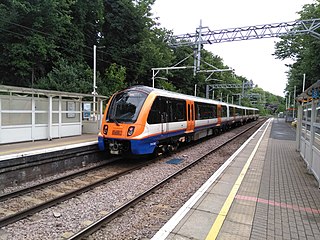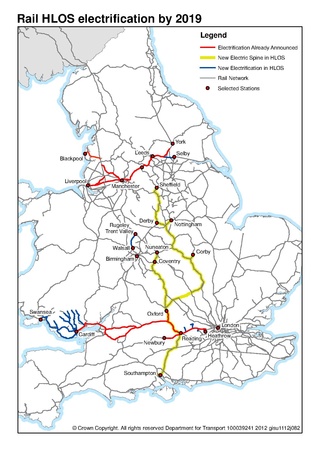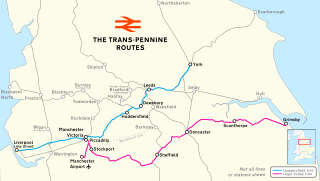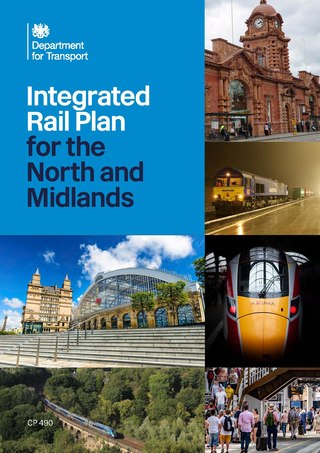
Network Rail Limited is the owner and infrastructure manager of most of the railway network in Great Britain. Network Rail is an "arm's length" public body of the Department for Transport with no shareholders, which reinvests its income in the railways.

The Gospel Oak to Barking line is a railway line in London. It is 13 miles 58 chains (22.1 km) in length and carries both through goods trains and London Overground passenger trains, connecting Gospel Oak in north London and Barking Riverside in east London. The line is part of Network Rail Strategic Route 6, and is classified as a London and South East Commuter line.

The Office of Rail and Road (ORR) is a non-ministerial government department responsible for the economic and safety regulation of Britain's railways, and the economic monitoring of National Highways.

Kearsley railway station serves the town of Kearsley and the outlying villages of Stoneclough, Prestolee and Ringley in Greater Manchester, England. It was originally named Stoneclough.

The South Wales Main Line, originally known as the London, Bristol and South Wales Direct Railway or simply as the Bristol and South Wales Direct Railway, is a branch of the Great Western Main Line in Great Britain. It diverges from the core London-Bristol line at Royal Wootton Bassett beyond Swindon, first calling at Bristol Parkway, after which the line continues through the Severn Tunnel into South Wales.

Corby railway station, owned by Network Rail and managed by East Midlands Railway, is in Corby, Northamptonshire, England. The current station, opened on 23 February 2009, replaces an earlier one dating from 1879, first closed on 18 April 1966 but reopened between 1987 and 1990.

The period from 1995 covers the history of rail transport in Great Britain following the privatisation of British Rail. During this period, passenger volumes have grown rapidly, safety has improved, and subsidies per journey have fallen. However, there is debate as to whether this is due to privatisation or to better government regulation. During this period, High Speed 1, the West Coast Main Line upgrade and Crossrail were completed and more construction projects are currently under way. The period also saw the demise of privately-owned Railtrack and its replacement with government-owned Network Rail.

In the 2010s Network Rail modernised the Great Western Main Line, the South Wales Main Line, and other associated lines. The modernisation plans were announced at separate times but their implementation overlapped in the 2010s.
The Edinburgh Glasgow Improvement Programme or EGIP was an initiative funded by Transport Scotland on behalf of the Scottish Government to increase capacity on the main railway line between Edinburgh and Glasgow, with new, longer electric trains running by 2017 and scheduled for full completion in 2019. It was expected to cost £742 million and delivered by Network Rail.

The Northern Hub was a rail upgrade programme between 2009 and 2020 in Northern England to improve and increase train services and reduce journey times between its major cities and towns, by electrifying lines and removing a major rail bottleneck in Manchester. It was predicted to stimulate economic growth in the region. The project has several elements but the prime objective is to eradicate the bottleneck in Manchester and allow trains to travel through the city at speed without stopping. The project was announced as the Manchester Hub in 2009. The project's steering partnership involves Network Rail, Deutsche Bahn, First TransPennine Express, Northern Rail, East Midlands Trains, CrossCountry, Freightliner, the Department for Transport, Transport for Greater Manchester and Merseytravel.

The "Electric Spine" was the name for part of a, now largely cancelled, rolling programme of railway electrification projects in England initially estimated to cost £800 million, but later thought to cost close to £3 billion. The aim was to form 25 kV AC overhead-wire electrified links northward from the Port of Southampton to major cities in northern and central England and dry port container terminals in the Midlands. The government wanted efficient electric-hauled freight trains to compete with road haulage.

Northern Powerhouse Rail (NPR), sometimes referred to unofficially as High Speed 3, is a proposed major rail programme designed to substantially enhance the economic potential of the North of England. The phrase was adopted in 2014 for a project featuring new and significantly upgraded railway lines in the region. The aim is to transform rail services between the major towns and cities, requiring the region's single biggest transport investment since the Industrial Revolution. The original scheme would have seen a new high-speed rail line from Liverpool to Warrington continuing to join the HS2 tunnel which it would share into Manchester Piccadilly station. From there, the line would have continued to Leeds with a stop at Bradford. The line was intended to improve journey times and frequency between major Northern cities as well as creating more capacity for local service on lines that express services would have been moved out from.
Mark Carne is a British businessman who served as executive vice-president for Shell in the Middle East and North Africa and was chief executive of Network Rail.

The Transpennine Route Upgrade (TRU) is a major investment being made in the railway between York and Manchester via Leeds and Huddersfield – the 76 miles (122 km) northern route over the Pennines, most of which is also known as the Huddersfield line. As of 2023, the line is heavily used but is slow and lacks capacity. It has Victorian infrastructure, covers difficult terrain including the 3-mile (4.8 km) Standedge Tunnel, and has poor access roads.

The Midland Main Line upgrade is an ongoing upgrade to the Midland Main Line, a railway line in the United Kingdom. There have been a number of proposals to electrify the line over many years but the 2012 proposal and announcement by the UK government was that it would include electrification of the railway line between Bedford, Wellingborough, Corby, Leicester, Derby, Nottingham and Sheffield. The routes between Nottingham and Sheffield and the Erewash Valley line were not included at this time, only the line between Derby and Sheffield. The upgrade was part of the HLOS - High Level Output Specification for Control Period 5 published by the UK Government in 2012. This was also part of a rolling programme of railway electrification projects. To enable all the benefits of using electric traction, the line south of Bedford into London St Pancras is also being progressively upgraded including boosting the power supply. Parts of the line have been classed as congested infrastructure hence another reason for the upgrade.

The Integrated Rail Plan for the North and Midlands or more simply, the Integrated Rail Plan (IRP), is a United Kingdom government proposal published on 18 November 2021. It aims to deliver "increased capacity, faster journeys or more frequent services on eight out of the top ten busiest rail corridors across the North and Midlands", by developing rail services along with the required infrastructure in these regions of England. It was published by the Department for Transport (DfT) and features forewords by Prime Minister Boris Johnson and Transport Secretary Grant Shapps, but its publication was delayed a number of times, partly because of the COVID-19 pandemic. It contains the significant proviso that "In line with the Government's existing approach to rail enhancements, commitments will be made only to progress individual schemes up to the next stage of development, subject to a review of their readiness." A Technical Annexe was published in January 2022. A correction slip was issued March 2022.
North West England electrification schemes are a series of individual railway lines in North West England that have been, and continue to be electrified and upgraded. It is planned that these schemes will result in a modernised, cleaner, lower carbon and faster railway with improved capacity.
Railway electrification in Scotland has proceeded in a different fashion than the rest of the UK especially in the 21st Century. There is political commitment to a substantial rolling programme of railway electrification from the Scottish government where transport is devolved. Transport Scotland and others have said "In Scotland, decarbonisation is spelt E-L-E-C-T-R-I-F-Y". All parties in Scotland are vigorously campaigning for electrification. As of January 2022, there is 2776 kilometres of track in Scotland, and 711 kilometres are electrified representing 25.3%. To meet these needs, the plan is to electrify on average 130 single track kilometres (STK) per year until 2035.

East West Rail is a major project to establish a strategic railway connecting East Anglia with Central, Southern and Western England. In particular, it plans to build a line linking Oxford and Cambridge via Bicester, Milton Keynes and Bedford, largely using the trackbed of the former Varsity Line. Thus it provides a route between any or all of the Great Western, Chiltern, West Coast, Midland, East Coast, West Anglia, Great Eastern and the Cotswold main lines, avoiding London. The new line will provide a route for potential new services between Southampton Central and Ipswich or Norwich via Reading, Didcot and Ely, using existing onward lines. The government approved the western section in November 2011, with completion of this section expected by 2025.













